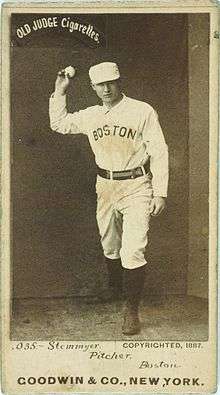Wild pitch
In baseball, a wild pitch (WP) is charged against a pitcher when his pitch is too high, too short, or too wide of home plate for the catcher to control with ordinary effort, thereby allowing a baserunner, perhaps even the batter-runner on an uncaught third strike, to advance.
.jpg)
A wild pitch usually passes the catcher behind home plate, often allowing runners on base an easy chance to advance while the catcher chases the ball down. Sometimes the catcher may block a pitch, and the ball may be nearby, but the catcher has trouble finding the ball, allowing runners to advance.
A closely related statistic is the passed ball. As with many baseball statistics, whether a pitch that gets away from a catcher is counted as a wild pitch or a passed ball is at the discretion of the official scorer. The benefit of the doubt is usually given to the catcher if there is uncertainty; therefore, most of these situations are scored as wild pitches. If the pitch was so low as to touch the ground, or so high that the catcher has to jump to get to it, or so wide that the catcher has to lunge for it, it is usually then considered a wild pitch and not a passed ball. Because the pitcher and catcher handle the ball much more than other fielders, certain misplays on pitched balls are defined in Rule 10.13 as wild pitches and passed balls. No error shall be charged when a wild pitch or passed ball is scored.

A wild pitch may only be scored if one or more runners advance. If the bases are empty, or the catcher retrieves the ball quickly and the runner(s) are unable to advance, a wild pitch is not charged. A scored run due to a wild pitch is recorded as an earned run. A runner who advances on a wild pitch is not credited with a stolen base unless he breaks before the pitcher begins his delivery.
Records
Nolan Ryan is the modern-era leader in the category, throwing 277 wild pitches over his 27 years in Major League Baseball. He also led his league in the category in six different seasons. However, the all-time record belongs to Tony Mullane, who threw 343 in the early years of the game from 1881 to 1894. After Ryan's 277, the next pitcher on the list is Mickey Welch 274, followed by Tim Keefe's 233.
Bill Stemmyer still holds the single-season record, throwing 63 wild pitches in 1886. Since 1900, however, the highest total in a season has been 30 (by Red Ames in 1905). The modern record in a single game is 6, held by three different pitchers.
R.A. Dickey, Phil Niekro, Walter Johnson, and Kevin Gregg all hold the modern-era regular season single inning wild pitch record with four. Rick Ankiel, however, threw five wild pitches in the 3rd inning of the first game of the 2000 NLDS. Bert Cunningham of the Players' League (considered a major league) in 1890 also threw five in an inning. Adam Ottavino on June 26, 2017 set the MLB record of five runs scored on four wild pitches.
The current active leader as of July 2019 is Félix Hernández, with 154 wild pitches. The only other active pitchers with 100+ wild pitches are Edwin Jackson with 105 and Francisco Liriano with 100.
Sources
External links
- Baseball Rules See section 10.13